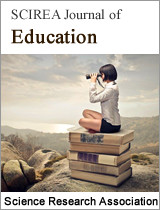Distance Teaching Mode and Practices in College English Course during COVID-19 Pandemic Crisis in China
DOI: 10.54647/education88248 90 Downloads 13557 Views
Author(s)
Abstract
During the COVID-19 pandemic in early 2020, many Chinese colleges and universities actively carry out distance online teaching, responding to the call of the Ministry of Education to "suspend classes without suspension of teaching and learning.” However, the integration of the Internet and education has changed the traditional education ecology and has also posed a huge challenge to the traditional teaching model. The research focuses on the teaching practices of on-line teaching of College English course and offers a detailed analysis of the changed teaching model adopted by China Jiliang University. The paper employs both quantitative and qualitative approaches to study the perceptions of teachers and students during the lockdown period, trying to construct a new online teaching mode by taking both of the feedback of students and the teaching reflection of teachers into consideration. It is hoped that the research results can provide some enlightenments for colleges and universities to deal with emergencies and expand online higher education in the future.
Keywords
COVID-19 Pandemic;Distance Teaching Mode;Feedback;Teaching Reflection
Cite this paper
Wang Lili,
Distance Teaching Mode and Practices in College English Course during COVID-19 Pandemic Crisis in China
, SCIREA Journal of Education.
Volume 6, Issue 5, October 2021 | PP. 130-157.
10.54647/education88248
References
| [ 1 ] | Yang XX,Chen DB, et al. Teaching and Learning from the Perspective of "Internet + Education”. Teaching and Management,2017;6: 26. |
| [ 2 ] | Horn M.B, Staker H. Blended using disruptive innovation to improve schools. San Francisco: Wiley, 2015:15-18. |
| [ 3 ] | Wang P. The Analysis of Learners' learning Habits Based on edX Open Data. Modern Education Technology,2015;4:92. |
| [ 4 ] | Jiang X, Hong M. The Innovation and Future of U.S. Higher Education Informationization—A Review of the Planning of Reshaping the Role of Technology in Higher Education. Modern Education Management, 2019;3:117. |
| [ 5 ] | Zhang N. Probe into the Teaching Mode of College English Flipped Class under the Background of MOOC. Heilongjiang Science,2017;4:131. |
| [ 6 ] | Future Ready Learning:Rethinking the Role of Technology in Education,National Education Technology Plan 2016. Washington D C :U. S. Department of Education [EB/O L]. [2016-03-13].http://tech.ed.gov. |
| [ 7 ] | Jiang X, Hong M. The Innovation and Future of U.S. Higher Education Informationization—A Review of the Planning of Reshaping the Role of Technology in Higher Education. Modern Education Management, 2019;3:119. |
| [ 8 ] | Yang XX,Chen DB, et al. Teaching and Learning from the Perspective of "Internet + Education”. Teaching and Management,2017;6: 24. |
| [ 9 ] | Jiang X,Hong M. The New Development of the U.S. Teacher Education Information Policy——Comments on the Federal Government's Promoting the Application of Educational Technology in Teacher Training. Journal of Jimei University (Educational Science Edition), 2019;4:2. |
| [ 10 ] | Guo H,Yao Y. Changes of a Decade in the Relationship between Teaching and Scientific Research of Research University Teachers. China Higher Education Research,2020;2:79. |
| [ 11 ] | Dong LL. Practice and Research of MOOC in College English Translation Teaching. Contemporary Teaching and Research Essays,2018;6: 12. |
| [ 12 ] | Lin XY,Song X. Promoting the "Excellent Teaching" of University Teachers: From Behaviorism to Reflective Recognition. Peking University Education Review,2014;2:47. |
| [ 13 ] | Wang JJ. Application of MOOC in College English Translation Course Teaching. Shaanxi Higher Education,2019;5:52. |
| [ 14 ] | Jiang X, Hong M. The Innovation and Future of U.S. Higher Education Informationization—A Review of the Planning of Reshaping the Role of Technology in Higher Education. Modern Education Management, 2019;3:119. |
| [ 15 ] | Chen XB,Yang XX. The "Digital Divide" in Online Education Era. Educational Observation, 2018;7:138. |

